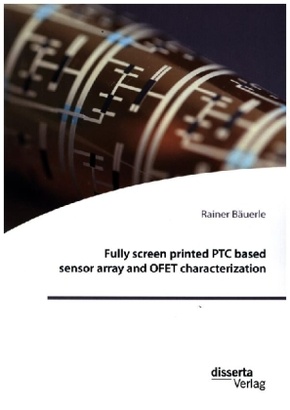Fully screen printed PTC based sensor array and OFET characterization
| Verlag | disserta |
| Auflage | 2024 |
| Seiten | 144 |
| Format | 15,6 x 0,8 x 22,2 cm |
| Gewicht | 218 g |
| Artikeltyp | Englisches Buch |
| ISBN-10 | 3959356323 |
| EAN | 9783959356329 |
| Bestell-Nr | 95935632A |
Diese Arbeit stellt ein neuartiges Sensorkonzept vor. Für kostengünstige und einfach anpassbare Produktion ist der gesamte Sensor siebgedruckt. Der Kern des Sensors ist ein Kaltleiter mit spezieller Widerstand-Temperatur-Charakteristik. Durch Messen des Wärmeflusses wird der Füllstand einer Flüssigkeit in einem Container gemessen. Der Sensor ist hierbei außen am Container und nicht im Inneren. Weiterhin kann der Sensor den Luftstrom messen. Dadurch wird es möglich, den Luftstrom an der Oberfläche von Objekten zu erfassen, ohne abstehende Messsonden in den Luftstrom zu platzieren. Zusätzlich zu diesen Sensoren werden OFETs für die Anwendung in einer Sensormatrix untersucht.Die hier entwickelten Sensoren ermöglicht eine einfache, anpassbare, und nachträgliche Installation einer Füllstandsmessung und erlauben eine Kartografierung des Luftstroms an der Objektoberfläche.
Leseprobe:
1. IntroductionSensors are part of every device nowadays. Cars incorporate sensors to obtain detailsabout their environment to a degree that allows autonomous driving [1, 2], peoplewear smartwatches with over 10 different kinds of sensors [3], and smart clothes withmultiple sensors have emerged [4, 5]. Research and development of sensors neverstopped and is driven by the desire to gain further and more detailed information oneverything. Discovery of electrically conductive polymers and subsequent research inconductive and semiconductive organic materials opened new and vast possibilitiesfor many sensors [6-9]. As the discovery revolutionized thinking about plastics inelectricity, the discoverers were awarded the Nobel Prize in 2000 [10]. Since then,a vast selection of different organic materials has been found and tailored to suitdifferent applications, many of which are of the sensory type. Materials changetheir properties, such as conductivity, depending on outer stimuli, meanin g theycan sense aspects of their environment. The new group of materials not only allowsfor new sensors by material properties, but also by their processibility. While mostclassical inorganic (semi-)conductors require high vacuum, high temperatures andfurther costly process conditions, many organic materials can be solution-processed,thereby circumventing the cost intensive requirements. Devices made out of organicelectronics can thus be fabricated and offered at a much cheaper price. Methods forsolution-processing include, among others, spin-coating, blade-coating, and, mostimportant for structured devices, various printing techniques [11-15]. Inkjet, aerosol,roll-to-roll, and screen printing can be utilized, depending on the materials' propertiesand ability to form suitable inks. These printing options allow for cost-effective massproduction, production runs with low quantities to single prototypes, or individualcustomization. Because most polymers are flexible and forgiving to bends, devices canbe fabricated on flexible substrates and mechanically new options become available.Perhaps the most eye-catching commercial flexible devices today (2023) are curvedand bendable displays which are - albeit still at a premium price - readily available[16, 17]. Less eye-catching, but nonetheless commercialized, are sensors based onorganic materials. The company InnovationLab GmbH developed and is alreadyselling organic sensor solutions1.Another well commercialized product are resettable fuses based on polymers. Theyheat up under power and limit currents. Current limitation is achieved by a strongtemperature-resistance correlation of the devices. Such correlations can be used1https://www.innovationlab.de/en/printed-electronics/products/, accessed 19.06.23.11. Introductionas a sensing principle. If the behavior of the device is known, a resistance canbe translated to a temperature, rendering the device a temperature sensor. Aswith most sensors, the measured variable ( resistance) and the concluded parameter(temperature) are not the same. Furthermore, the first concluded parameter can beinterpreted for further assumptions. In a heated device, the equilibrium temperaturedepends on the environment's ability to absorb heat. An environment with goodheat absorption or conduction keeps the device cooler. The measured temperaturecan therefore be interpreted to obtain thermal information about the environment.Elevated temperatures, however, are a major challenge for organic electronics.Further challenges are short lifetimes and quick degradation [18-20], both oftenlinked with weak performance under elevated temperatures. Commercial materialsare tested and optimized and can therefore be used right away in applications anddevices (within their specifications). Lifetime and longevity are thus good. New labmaterials, however, are often severely limited in their applications. Development ofair-stable and long-living materials a

